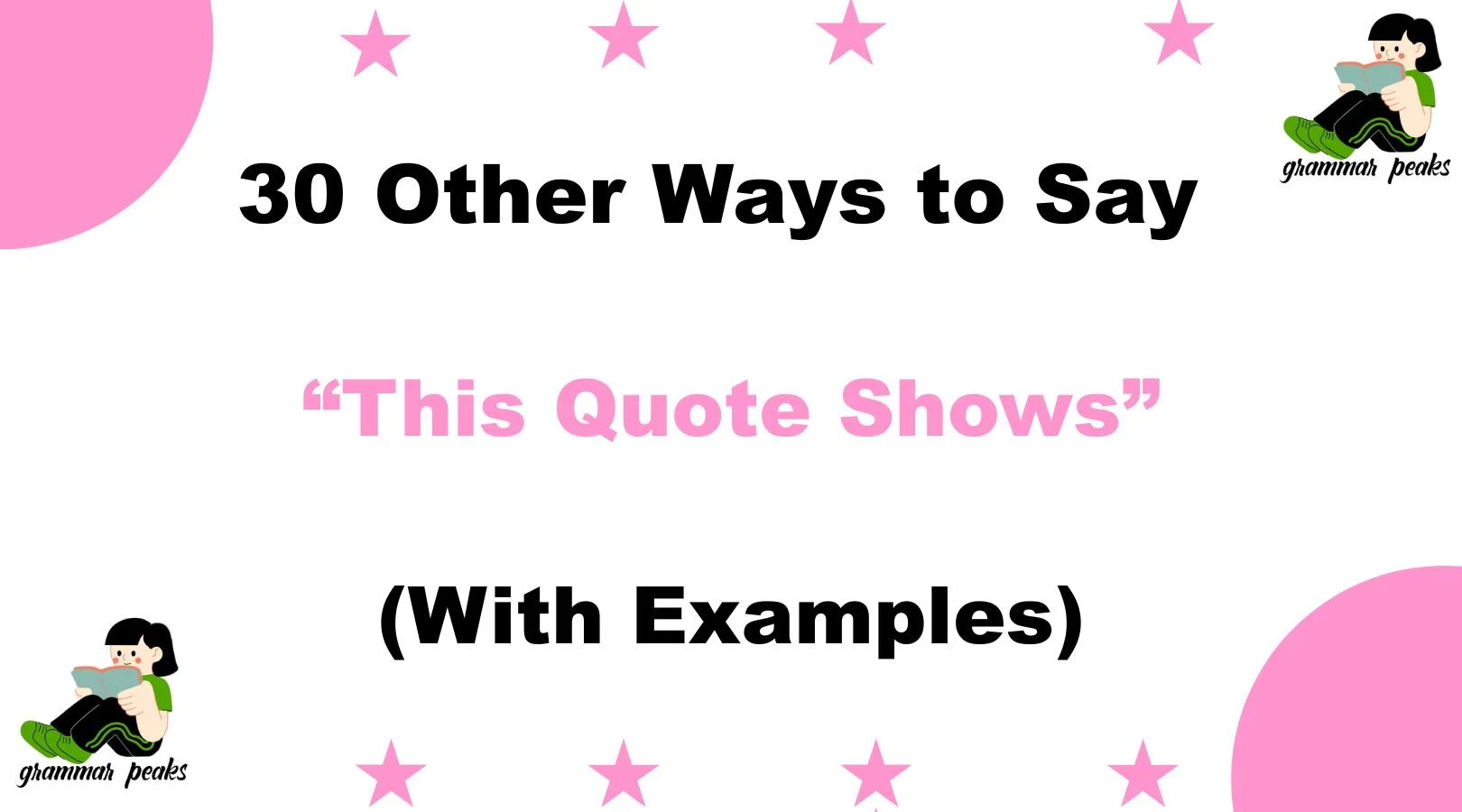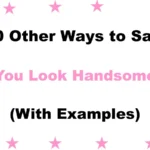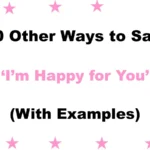Finding the right words when analysing or reflecting on a quote can make all the difference. Whether you’re writing an essay, composing a thoughtful message, or sharing insights on social media, the phrase “this quote shows” can sometimes feel a bit flat or overused.
By using warmer, more expressive alternatives, you can add more heart, depth, and clarity to your message. In this article, you’ll discover 30 thoughtful ways to say “this quote shows”—each with examples, definitions, and the ideal tone for different settings. These options can help your communication feel more personal, polished, and impact.
What Does “This Quote Shows” Mean?
“This quote shows” is a common phrase used to introduce an interpretation, insight, or analysis of a specific line from a text. It signals to the reader that you’re about to explain the meaning or significance behind what was just quoted. This phrase is especially popular in academic writing, literature essays, and reflective analysis because it helps bridge the gap between evidence and interpretation.
However, while it’s straightforward and clear, using it too often can make your writing feel repetitive or basic. That’s why exploring more expressive and thoughtful alternatives can elevate your tone and better connect with your audience.
When to Use “This Quote Shows”
Use this phrase when:
- You’re writing a literary analysis or commentary
- You need to support a claim with textual evidence
- You want to connect a quote to a theme, lesson, or personal viewpoint
Is It Professional/Polite to Say “This Quote Shows”?
Yes, it’s generally polite and professional—especially in academic writing or presentations. However, it can come off as repetitive if used too often, and alternatives can sound more mature, refined, or empathetic, depending on your audience.
Pros and Cons of Saying “This Quote Shows”
Pros:
- Clear and direct
- Easy for academic audiences
- Familiar in essay structures
Cons:
- Can feel robotic or overused
- Lacks emotional tone or creativity
- Doesn’t always engage readers deeply
Synonyms for “This Quote Shows”
- This reflects
- This illustrates
- This highlights
- This captures
- This emphasizes
- This supports the idea
- This expresses
- This reveals
- This portrays
- This affirms
- This proves
- This communicates
- This underlines
- This exemplifies
- This draws attention to
- This suggests
- This conveys
- This demonstrates
- This implies
- This resonates with
- This brings to light
- This uncovers
- This connects with
- This indicates
- This echoes
- This underscores
- This presents
- This speaks to
- This explains
- This reminds us
1. This reflects
Definition: This means the quote mirrors or represents a larger idea, emotion, or truth.
Detailed Explanation: Use this phrase when the quote connects deeply to a recurring theme, value, or belief, offering insight into the character, speaker, or message.
Scenario Example: This reflects the speaker’s desire for freedom and resistance against conformity.
Best Use: Best for analyzing emotional depth in literature or personal reflections.
Worst Use: Avoid using in technical or scientific summaries, where precision is preferred over interpretation.
Tone: Warm, introspective, and analytical.
2. This illustrates
Definition: This means the quote clearly shows or demonstrates an idea through its content.
Detailed Explanation: This is useful when the quote helps to paint a mental picture, clarify a concept, or support an argument with evidence.
Scenario Example: This illustrates how ambition can blind people to moral consequences.
Best Use: Strong choice for essays, presentations, and written analyses in academic settings.
Worst Use: Less effective in informal or conversational writing, where natural language may be better.
Tone: Neutral, explanatory, and informative.
3. This highlights
Definition: This means the quote brings attention to something important or notable.
Detailed Explanation: It’s ideal for pointing out critical insights or key moments emphasized in a quote.
Scenario Example: This highlights the tension between the individual and society in the story.
Best Use: Academic discussions, articles, or commentary on complex issues.
Worst Use: Not ideal for everyday speech or overly casual writing.
Tone: Professional, assertive, and clear.
4. This captures
Definition: This means the quote successfully contains or expresses an emotion, scene, or thought.
Detailed Explanation: Use when a quote perfectly represents a mood, atmosphere, or feeling.
Scenario Example: This captures the loneliness the character feels despite being surrounded by people.
Best Use: Creative writing, emotional storytelling, or personal blogs.
Worst Use: Avoid in data-heavy or logical analyses where emotion isn’t the focus.
Tone: Poetic, expressive, and vivid.
5. This emphasizes
Definition: This means the quote stresses or draws focus to a particular idea or message.
Detailed Explanation: Good for reinforcing a main theme or value that’s been introduced previously.
Scenario Example: This emphasizes the need for compassion in leadership.
Best Use: Persuasive essays, reflective writing, or thematic breakdowns.
Worst Use: Not suitable in purely factual or numerical reports.
Tone: Passionate, persuasive, and focused.
6. This supports the idea
Definition: This means the quote adds evidence or backing to a stated viewpoint or argument.
Detailed Explanation: Use when you’ve already made a point and the quote strengthens or validates it.
Scenario Example: This supports the idea that hard work often goes unnoticed.
Best Use: Argumentative essays, formal reports, and structured debates.
Worst Use: Don’t use it in creative or poetic writing where subtlety is preferred.
Tone: Logical, structured, and formal.
7. This expresses
Definition: This means the quote conveys a particular emotion, thought, or viewpoint.
Detailed Explanation: Best when a quote clearly reveals how someone feels or what they believe.
Scenario Example: This expresses the frustration felt by workers ignored by the system.
Best Use: Emotional analysis, journaling, social commentary.
Worst Use: Not suited for objective writing or scientific content.
Tone: Honest, emotional, and personal.
8. This reveals
Definition: This means the quote uncovers something not immediately obvious or hidden.
Detailed Explanation: Use when the quote shows a deeper truth, secret, or underlying issue.
Scenario Example: This reveals the author’s internal conflict with societal expectations.
Best Use: Psychological analysis, character study, or hidden meanings.
Worst Use: Less fitting in instructional or practical documents.
Tone: Thoughtful, unveiling, and deep.
9. This portrays
Definition: This means the quote paints a picture of someone’s character, feelings, or situation.
Detailed Explanation: Best for describing how a person or situation is shown in a vivid or emotional way.
Scenario Example: This portrays the fear that consumes the village during the outbreak.
Best Use: Descriptive writing, literature essays, and narratives.
Worst Use: Avoid factual or procedural writing.
Tone: Visual, dramatic, and expressive.
10. This affirms
Definition: This means the quote confirms or validates a belief or conclusion.
Detailed Explanation: Use when the quote reassures, strengthens, or provides certainty to a claim.
Scenario Example: This affirms that honesty remains a core value in the character’s decisions.
Best Use: Conclusions, debates, and strong assertions.
Worst Use: Not great in open-ended or speculative discussions.
Tone: Confident, clear, and affirmative.
11. This proves
Definition: This means the quote offers solid evidence for a claim or idea.
Detailed Explanation: Use when you want to present the quote as undeniable support for an argument.
Scenario Example: This proves the author’s belief that kindness can lead to change.
Best Use: Formal debates, essays, or when making a strong factual point.
Worst Use: Avoid in poetic or interpretive writing where proof isn’t necessary.
Tone: Assertive, factual, and confident.
12. This communicates
Definition: This means the quote effectively sends a message or delivers a clear idea.
Detailed Explanation: Use when a quote helps convey meaning in a straightforward or emotional way.
Scenario Example: This communicates the silent suffering of the character.
Best Use: Essays, speeches, or content where tone and delivery matter.
Worst Use: Avoid highly technical or data-driven content.
Tone: Clear, human-centered, and meaningful.
13. This underlines
Definition: This means the quote places special emphasis on a certain idea.
Detailed Explanation: Helpful when you want to stress the importance of what’s being said.
Scenario Example: This underlines the ongoing need for justice in the story’s conclusion.
Best Use: Literary analysis, reflective writing.
Worst Use: Not ideal in casual dialogue or creative fiction.
Tone: Emphatic, strong, and scholarly.
14. This exemplifies
Definition: This means the quote serves as a perfect example of a concept or idea.
Detailed Explanation: Great when a quote neatly fits or models what you’re discussing.
Scenario Example: This exemplifies how loyalty can survive even in the darkest times.
Best Use: Academic or educational writing.
Worst Use: May sound too formal in blogs or personal conversations.
Tone: Academic, precise, and instructional.
15. This draws attention to
Definition: This means the quote directs focus toward a key message or issue.
Detailed Explanation: Use when a quote highlights something that may otherwise go unnoticed.
Scenario Example: This draws attention to how society treats the vulnerable.
Best Use: Social justice writing, persuasive pieces.
Worst Use: Not ideal in overly technical or data-focused writing.
Tone: Intentional, compelling, and alerting.
16. This suggests
Definition: This means the quote implies or hints at an idea without directly stating it.
Detailed Explanation: Useful when the quote requires interpretation and opens room for insight.
Scenario Example: This suggests the character has unresolved fears about abandonment.
Best Use: Reflective writing, psychological analysis.
Worst Use: Avoid in factual writing where clarity is key.
Tone: Subtle, interpretive, and reflective.
17. This conveys
Definition: This means the quote delivers a message or shares a feeling effectively.
Detailed Explanation: Perfect when you want to show what’s being emotionally or mentally transferred through words.
Scenario Example: This conveys the quiet strength of the narrator in the face of grief.
Best Use: Emotional narratives, personal reflections.
Worst Use: Not well suited for technical or procedural content.
Tone: Expressive, heartfelt, and intentional.
18. This demonstrates
Definition: This means the quote clearly shows how something works, feels, or functions.
Detailed Explanation: Use when the quote visibly proves or shows a trait, principle, or outcome.
Scenario Example: This demonstrates how empathy can transform relationships.
Best Use: Formal essays, instruction-based writing.
Worst Use: Avoid highly subjective or poetic reflections.
Tone: Objective, strong, and practical.
19. This implies
Definition: This means the quote hints at something indirectly or subtly.
Detailed Explanation: Best used when the meaning is not obvious but can be inferred from the quote.
Scenario Example: This implies the leader regrets the choices made during the war.
Best Use: Analytical writing, literary critique.
Worst Use: Not fitting in straightforward or literal explanations.
Tone: Thoughtful, reserved, and inquisitive.
20. This resonates with
Definition: This means the quote emotionally connects or aligns with a shared feeling or idea.
Detailed Explanation: Use when the quote touches something universally understood or personally moving.
Scenario Example: This resonates with anyone who’s experienced loss and resilience.
Best Use: Inspirational content, memoirs, speeches.
Worst Use: Less fitting in academic or technical articles.
Tone: Empathetic, personal, and emotional.
21. This brings to light
Definition: This means the quote uncovers or exposes something that needs attention.
Detailed Explanation: Ideal when the quote addresses truths that have been ignored or hidden.
Scenario Example: This brings to light the struggles faced by underrepresented communities.
Best Use: Social critique, awareness campaigns.
Worst Use: Not suitable for dry, instructional writing.
Tone: Revealing, urgent, and bold.
22. This uncovers
Definition: This means the quote reveals something that was not obvious before.
Detailed Explanation: Best for showing hidden truths, character flaws, or secrets.
Scenario Example: This uncovers the guilt the narrator tries to hide behind humor.
Best Use: Literary analysis, dramatic writing.
Worst Use: Avoid in formal business or nonfiction manuals.
Tone: Deep, raw, and investigative.
23. This connects with
Definition: This means the quote relates directly to a reader, theme, or emotion.
Detailed Explanation: Use when there’s a personal or emotional bridge built through the quote.
Scenario Example: This connects with the fear many feel when stepping into the unknown.
Best Use: Motivational writing, storytelling.
Worst Use: Technical writing or where emotion isn’t the goal.
Tone: Relational, warm, and inviting.
24. This indicates
Definition: This means the quote points toward a conclusion or piece of information.
Detailed Explanation: Often used when a quote supports an observed pattern or idea.
Scenario Example: This indicates the character’s loss of hope by the end of the story.
Best Use: Data-driven analysis, research commentary.
Worst Use: Less suitable in poetic or fictional prose.
Tone: Measured, careful, and analytical.
25. This echoes
Definition: This means the quote repeats or reinforces an earlier idea or theme.
Detailed Explanation: Use when the quote aligns with a sentiment mentioned previously.
Scenario Example: This echoes the narrator’s earlier warning about pride.
Best Use: Literature essays, theme-driven writing.
Worst Use: Doesn’t fit casual or sales writing well.
Tone: Reflective, consistent, and thematic.
26. This underscores
Definition: This means the quote places strong emphasis on something crucial.
Detailed Explanation: Useful when the quote makes a repeated or reinforced point.
Scenario Example: This underscores the importance of listening with empathy.
Best Use: Persuasive content, educational pieces.
Worst Use: Overkill in light or humorous writing.
Tone: Firm, powerful, and deliberate.
27. This presents
Definition: This means the quote offers or introduces an idea to consider.
Detailed Explanation: Best when the quote lays out a concept or proposal directly.
Scenario Example: This presents a compelling view of freedom through solitude.
Best Use: Informative articles, discussion prompts.
Worst Use: Too neutral for deeply emotional writing.
Tone: Balanced, thoughtful, and neutral.
28. This speaks to
Definition: This means the quote addresses a deeper idea, experience, or emotion.
Detailed Explanation: Great for showing how the quote relates to universal or timeless truths.
Scenario Example: This speaks to the human need for connection, even in silence.
Best Use: Inspirational writing, reflective essays.
Worst Use: Inappropriate for scientific analysis.
Tone: Profound, relatable, and sincere.
29. This explains
Definition: This means the quote clarifies or makes something more understandable.
Detailed Explanation: Use when a quote helps break down a complex or abstract idea.
Scenario Example: This explains why the character chose isolation over conformity.
Best Use: Instructional or analytical writing.
Worst Use: Avoid emotional or symbolic interpretation.
Tone: Clear, instructional, and direct.
30. This reminds us
Definition: This means the quote brings something back into focus or memory.
Detailed Explanation: Best when the quote evokes values, feelings, or historical lessons.
Scenario Example: This reminds us how small acts of kindness can change a life.
Best Use: Speeches, lessons, or commemorative writing.
Worst Use: Too emotional for dry academic reports.
Tone: Gentle, reflective, and human.
Conclusion
Choosing how to describe a quote’s impact isn’t just about sounding smarter—it’s about being clear, intentional, and emotionally connected. Whether you’re writing for class, reflecting in a journal, or crafting a speech, swapping out “this quote shows” for something more expressive can make your message feel more meaningful, more human, and more powerful.These 30 alternatives give you flexibility in tone and purpose, helping you communicate with warmth, clarity, and authenticity.
FAQs
1. Can I use these alternatives in school essays?
Yes! Most of these phrases are academic-friendly and can even improve the tone of your writing.
2. Which alternative is best for emotional or poetic writing?
Phrases like “this resonates with,” “this captures,” or “this speaks to” work beautifully in expressive or personal writing.
3. Are these alternatives suitable for professional writing?
Absolutely—options like “this demonstrates,” “this indicates,” and “this supports the idea” are perfect for professional reports and presentations.
4. How can I avoid sounding repetitive when analyzing quotes?
Use a mix of these phrases, depending on what the quote does—emphasise, reveal, suggest, or affirm.
5. Is it okay to use the same alternative multiple times in one piece?
It’s okay, but variety adds richness. Try alternating between three or four expressions to keep your writing fresh and engaging.

Mariah Cannon is a dedicated Senior Content Specialist at GrammarPeaks, known for her clear, engaging writing and deep knowledge of English grammar and usage. With a background in linguistics and years of experience in content development, Mariah crafts informative and accessible articles that empower readers to master the nuances of the English language. Her work reflects a commitment to clarity, education, and helping others express themselves with confidence.





